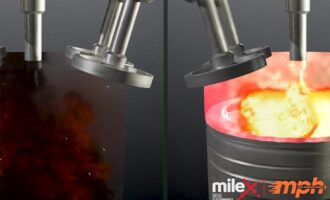A European Bonanza
By Vicky Villena-Denton
For SK Lubricants, producing Group III base oils in Europe made a lot of sense. Europe is the major market for Group III, and until the third quarter of 2014, SK was supplying Europe from Ulsan, South Korea. It was sending two shiploads per month to Rotterdam, where it had a storage capacity of 120,000 metric tonnes (MT).
The opportunity to partner with a European refiner came about when Spain’s Repsol decided to upgrade its Cartagena refinery, which included installing a hydrocracker. This triggered “the start of the conversation,” said Alan Bell, SK Lubricants’ sales director in Europe based in London.
The EUR 3.1 billion (USD 3.4 billion) investment increased the distilling and conversion capacity of the refinery to maximise the production of middle distillates, which were in short supply in Europe, decreased the production of fuel oils and allowed it to process heavier crude oils.
The other attraction for SK was the residue from the hydrocracking units in Spain. The residue is the feedstock for the base oil plant, and was similar to what SK’s plant in Ulsan, South Korea, was using. Additionally, Repsol was willing to partner with SK Lubricants as a shareholder owning 30% of the joint venture firm Iberian Lube Base Oils Company. The partners announced their project in November 2011, and by September 2014, the JV started production. About EUR 250 million (USD 273 million) was invested in this project.
 SK plans to source most of its European sales from this plant and to send perhaps only one shipload of base oils to Europe per quarter.
SK plans to source most of its European sales from this plant and to send perhaps only one shipload of base oils to Europe per quarter.
“Predominantly, we can be self sufficient with European production,” Bell said.
With a processing capacity of 630,000 metric tonnes per annum (MTPA), the Cartagena plant is two and a half times the size of Neste Oil’s Porvoo Group III plant in the Kilpilahti industrial area, 30 kilometres east of Helsinki, Finland. These two are the only significant Group III base oil producers in Europe.
Cartagena used to be a small fishing port, just south of Alicante, Spain. The plant mostly produces 3-, 4- and 6-centistoke Group III base oils, Bell said, although there are plans to produce heavier grades this year.
Bell said the key to SK’s success is that the company is the “only real global player, and that’s what the majors latched onto.”
“The big players with plants all over the world want the same formulation and a supplier that is available worldwide,” he said.
Bell said the European market is one of the most complex in the world.
“One of the things about the European market is that it’s probably one of the most complex in the world as a region in regard to automotive lubricants,” Bell said. “There’s a big proliferation of OEMs that’s very keen to have a big say in lubricants and they go in some detail to assess… what they think we need for the next generation oils, etc. They started going into the synthetic route 10 years ago,” he said.
In the past, there was a big debate whether Groups II and III should be classified as synthetic base oils. This issue was never settled within a technical forum like Technical Committee 1 of the Society of Automotive Engineers (now SAE International). It was left to the marketplace and the courts to decide what “synthetic” means. Today, the term is loosely used to encompass Groups II and III, along with poly alpha olefins (PAOs), the synthetic base stock used in Mobil 1. Mobil (now ExxonMobil) was a pioneer in the synthetic lube market.
While North America went the Group II route, Europe went with Group III. Both are cheaper routes to formulate higher quality lubricants than PAO, which also happens to be in short supply. Bell explains why.
“Europe once upon a time was more than self-sufficient with Group I plants and there wasn’t much opportunity to get rid of those plants…. so Group I was the main product [in Europe],” he said.
“Shell in the 1970s in fact was probably one of the first to start producing Group III with XHVI in France. As the market became more interested in Group III, top-tier engine oils were starting to be formulated with Group III.”
At that time, the Shell refinery in Petit Couronne, France was producing around 50,000 MTPA of Group III, in addition to Group I. Eventually, Shell began to back away from third-party sales and predominantly started using XHVI internally. This created an opportunity for SK. The plant was eventually sold to PetroPlus Holdings AG in 2008, which operated it until the company was declared insolvent in 2012. Buteven before then, the XHVI unit had to be shut down because the waxy feedstock required to produce XHVI was not available in Europe.
Bell said that while there hasn’t been much volume growth in Europe, technical requirements from the automotive sector continue to drive Group III demand. U.S.-based Chevron Corp. has been expanding its presence in Europe by bringing in Group II base oils, which compete with both Group I and III, from its newly expanded plant in Pascagoula, Miss., U.S.A.
Regarding the future, Bell said, “It could be another two or three years before we see the market catch up with demand to the point where there is tightness again.”
Despite today’s economic climate, the Cartagena refinery was the perfect opportunity for SK Lubricants to establish a footprint in Europe.
echo '






